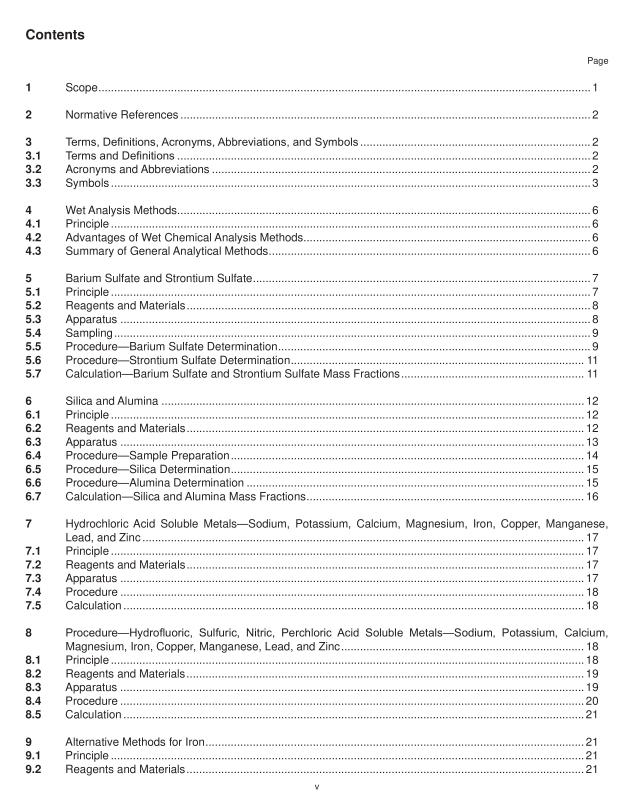API RP 13K pdf download

API RP 13K pdf download Chemical Analysis of Barite
The only HCl insoluble Na and K compounds sometimes found in barite are Na and K feldspars,which aresoluble in HF/H,SO HNO,mixed acids. The difference in Na and K values obtained by these two extractions cangive an estimate of Na and K feldspars in barite.
4.3.5 Calcium(Ca), magnesium (Mg), and iron (Fe)
Hydrochloric acid (HCl) or hydrofluoriclsulfuric/nitric acid (HFH,SO/HNO,) extraction, or both, then AA or ICPanalysis.
Following are compounds of Ca,Mg,or Fe sometimes found in barite, that are insoluble in HCl, but soluble inthe HF/Hi,so,/HNO,mixture; the difference in Ca, Mg, and Fe values obtained by these two extractions can giveestimates of these compounds in barite: fluorite (CaF.) , talc(hydrous magnesium sillicate), montmorllonite (Mgis usually present in lattice structure), and pyrite (Fes2).
4.3.6 Alternative methods for iron (Fe)
Extraction with nitric (HNO,) or with hydrochloric/nitric (HCVHNO,) acid, or fuse with carbonate, then determineby AA or ICPanalysis.
4.3.7 Copper (Cu), manganese (Mn), lead (Pb), and zinc(Zn)Hydrochloric acid (HCI) extraction, then AA analysis.
4.3.8 Siderite (Feco,)
Ethylene diamine tetraacetic acid dihydrate (EDTA)/sodium hydroxide (NaOH) extraction, thenAAorICPanalysis.4.3.9 Total carbonate (co,-3)
Determine by the Garrett Gas Train(GGTy method.4.3.10 Sulfide (S-)
Determined by the GGT method; alternative procedure—-treat with 1 molL HCl or 0.5 molLH,So , analyze HSevolved with lead acetate paper.
4.3.11 Water soluble analysis
Barite is extracted with an equal weight of deionized water, and filtrate is analyzed for elements of interest bytitration.AA,ICP, and flame emission techniques.
4.3.12 Loss on ignition (Lor)
Weight loss after heating to 1000 “C (1830 °F), due to combined water lost from clays, decomposition ofcarbonates or organic and carbonaceous matter.
4.3.13 Calcium hydroxide (lime) or cement content
Extract with an aqueous solution of sugar,and the lime/cement content titrated with standardized HCl solution.
5Barium Sulfate and Strontium Sulfate
5.1Principle
This procedure determines barium sulfate (BaS0 ,) and strontium sulfate (SrSO,) in barites by fusion with sodiumcarbonate (Na.CO.), dissolution with hydrochloric acid (HClI) and measurement of barium (Ba) gravimetrically by sulfate precipitation and, of strontium (Sr) by atomic absorption (AA) or inductively coupled plasma (ICP) analysis.
5.2 Reagents and Materials
WARNING Concentrated acids (hydrochloric or sulfuric) are strong, potentially harmful acids. Use proper safety precautions when handling them.
5.2.1 Deionized or distilled water shall be in accordance with ISO 3696 of at least Grade III.
Use deionized or distilled water for preparation of all reagents and calibration standards and as dilution water.
5.2.2 Sodium carbonate (Na 2 CO 3 ) (CAS No. 497-1 9-8), anhydrous, ACS grade powder.
5.2.3 Sodium carbonate solution (0.2 % w/w), 1 .0 g Na 2 CO 3 dissolved in 500 mL deionized water.
5.2.4 Hydrochloric acid solution 6 mol/L (6N) (CAS No. 7647-01 -0), ACS reagent grade.
5.2.5 Sulfuric acid solution 10 % w/w (CAS No. 7664-93-9), ACS reagent grade.
5.2.6 Sulfuric acid solution 1 % by volume (CAS No. 7664-93-9), ACS reagent grade.
5.2.7 Strontium AA or ICP standards, 5 mg/L, 1 0 mg/L, and 1 5 mg/L Sr in 1 % w/w HCl.
5.2.8 Ammonium hydroxide (CAS No. 1 336-21 -6), NH 4 OH, concentrated (28 % to 30 %), ACS reagent grade.
5.2.9 Methyl orange indicator solution (CAS No.547-58-0), 0.1 g methyl orange diluted to 1 00 mL with
deionized water.
5.3 Apparatus
5.3.1 Mortar and pestle.
5.3.2 Sieve, 150 μm (0.0059 in.-U.S. sieve No.100).
5.3.3 AA or ICP spectrophotometer, any AA or ICP unit is suitable. Instrument settings recommended by the manufacturer should be followed.
5.3.4 Analytical balance, with accuracy of 0.001 g (1 mg).
5.3.5 Stirring rod, glass, or polytetrafuoroethylene (PTFE) equivalent plastic, one end ftted with a rubber policeman.
5.3.6 Crucibles and lids, platinum, two 25 mL.
5.3.7 Crucible tongs, one 25 cm (1 0 in.) or one 50 cm (20 in.).
5.3.8 Muffe? furnace, regulated to 1 000 °C ±20 °C (1 830 °F ±35 °F).
5.3.9 Beakers, four 250 mL, two 400 mL, and two 600 mL.
5.3.10 Watch glasses, two fitted for 250 mL beaker and two fitted for 600 mL beaker.
5.3.11 Hot plate.
5.3.12 Funnels, glass, two, 65 mm (2.5 in.) long stem.









